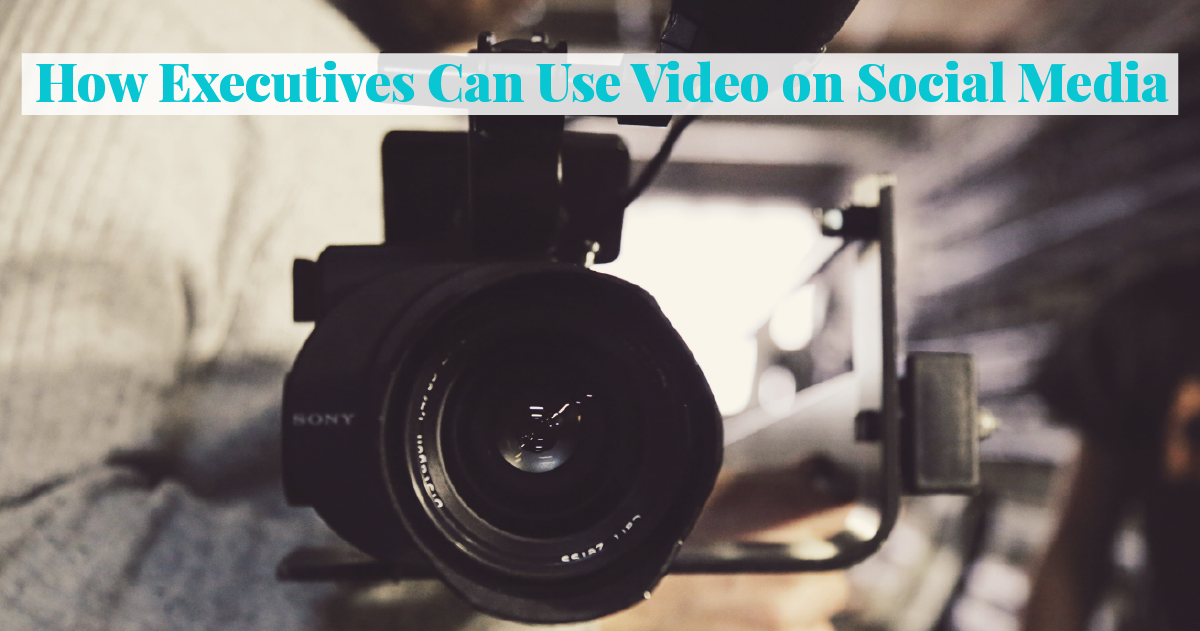Content mix is an important factor when developing a social media strategy for executives. Original video content draws a great deal of engagement among users and sets the executive apart from those who are not utilizing video as part of their strategy. While the majority of social media content is comprised of text or images, videos have grown to become an important part of online content diversity. In fact, one study showed that social media posts with a video gets shared by users 1200% more than other types of posts, such as text and images. In this article, we will be discussing how original video content can benefit executives on social media by giving them another way to connect with their followers.
Why Executives Should Implement Video Content
When it comes to video content, many studies have shown how important this type of content has become online. One study found viewers remembered 95% of a message when it is delivered in a video. On the other hand, only 10% remembered the message when it is delivered through text only.
Creating original video content is an effective way to convey specific messaging that can help them and their brand achieve business goals, such as growing brand awareness or driving leads. Videos also allow executives to speak directly to the user or share content that is important to them, making it more personal compared to videos posted on a brand page.
Video Topics and Format for Executives on Social Media
Videos can use a variety of formats and cover many different topics. When thinking about how to structure a video, consider the type of video and platform the content is being posted to. For example, an Instagram Story is only 15 seconds versus a LinkedIn video that can be up to 10 minutes, and a Facebook video that can be two hours!
First, let us look at some popular video formats executives can use in their own content.
Format
Traditional:
One of the most common video formats is traditional, which means the video is pre-recorded by the executive and then posted to their social media. Some examples of traditional videos include pre-recorded announcements and brand-related advertisements.
Q&A/Interview:
Users who follow executives on social media want to learn more about them and their brand. By utilizing a question and answer format, executives can create engaging, informative videos for their users. Executives can also use this opportunity to drive more engagement, such as asking their followers to submit questions before the video is recorded. An example is Ed Bastian’s Q&A video below. He has also used a branded hashtag, #AskEdAnything, in order to gather user questions.
Live video:
Another popular video format is live video, which many social media platforms are now offering. While executives can use a script or outline as an aid to guide them, live videos are more spontaneous when compared to a traditional video. Live video features typically allow users to post comments in an accompanying live chat. Executives can interact with their followers in real time. An example is John Legere’s live Twitter.
#LIVE @TMobile CEO: Happy Sunday! #Runscope; It’s been a busy week so come on in and lets catch up! 🙌🏼🗣 https://t.co/thDBaB09pc
— John Legere (@JohnLegere) February 23, 2020
Next, what are some topics executives can talk about in their videos?
Topics
Brand:
One of the most common topics executives share on social media is brand-related content. This is an overarching theme that can overlap with some of the other topics discussed below. When brand-related content is delivered by an employee rather than a business account, it feels more authentic to users as it is coming from an individual, rather than a faceless brand account. One study found that 72% of consumers prefer learning about a product or service through a video.
Behind-the-scenes:
When interacting with a business, consumers are often only exposed to one side of the brand. However, online users are interested in learning more about what goes on at a company. Behind-the-scenes videos lets users go where they normally would not have access to. Some examples include going into the kitchen at a restaurant and talking to the staff, or visiting the production line at an auto company.
Social causes:
For many executives, promoting social causes on social media is an important part of their content strategy. From climate change to gender equality, we have seen executives share third-party articles, original photos, and make personal comments. Video gives executives the chance to show that they are actively involved in social causes and making a direct impact. An example is YouTube’s CEO, Susan Wojcicki, posting a video about the #TeamTrees initiative on her YouTube channel.
Personal:
Lastly, another popular topic for executives is personal content. This type of video is generally unrelated to the brand and can be heavily influenced by the executive’s own personality. When executives are portrayed in a more candid way, they become more relatable to viewers.
Executives Currently Using Video in Their Social Media Strategy
Now, let us look at three different executives and see how video contributes to their social media strategy. Each of the executives use different video formats/topics, social media platforms, and delivers unique content.
Tim Cook on Twitter
First up is Apple CEO, Tim Cook. His videos on his Twitter account relate to the Apple brand in some way, whether it is an advertisement or featuring previous executives and employees. Here are two examples:
Thinking of Steve today on his birthday — his friendship, passion, and especially the laughter and joy he inspired. pic.twitter.com/qPMHbzxCsQ
— Tim Cook (@tim_cook) February 24, 2020
When you add up every ambitious dreamer, every daring creator, every impatient striver searching for a better life, you get the story of America. Apple is committed to sharing stories like those in our new series, Little America — stories that matter. pic.twitter.com/9x2bTEad2v
— Tim Cook (@tim_cook) January 18, 2020
Although his other Twitter content features a wide variety of topics from entertainment to social causes, his video content focuses on highlighting Apple. His videos all tell a story about the Apple brand, promoting Apple products and how they have made a positive contribution to our lives.
Cook’s videos are about promotion but from an authentic perspective that uses a narrative to make the content more relatable to the view. One key aspect to note is that Cook is rarely featured in the videos. When creating content, executives do not necessarily have to be the focus of the video itself.
John Legere on Instagram
T-Mobile CEO, John Legere, is an example of an executive that makes effective use out of all the social media platforms he is on. With a deep understanding of each platform, his content has been curated to provide users with a variety of different videos on each platform.
For example, on Instagram he frequently posts short Q&A videos answering user questions. Because these are shorter videos, they are posted to his main feed and provide users with a mix of content types to engage with.
By answering these questions, social media users learn more about him, both as an executive and as a person. Legere is also famous for his #SlowCookerSunday, which is broadcast through Facebook Live (and are automatically saved to the video section).
Mixing T-Mobile branding with his love for cooking, Legere is both promoting his company and his own personal interests. Because of the unique content (after all, not many executives have their own cooking show), his videos receive a lot of engagement through live chats, likes, and millions of views.
Bill Gates on LinkedIn
Last but not least is Microsoft co-founder, Bill Gates, on LinkedIn. Gates’ videos use a traditional format, emphasizing high-quality production. One key feature that sets Gates’ videos apart is that he consistently uses captioning. This makes the content more accessible to viewers.
Not all of his videos focus on his company. Other content deals with topics that he is passionate about. This includes social issues and speaking to other individuals from other industries.
Similar to Legere’s video content, Gates features prominently in his video content. He is often narrating or is actively engaged in the conversation. This type of approach gives viewers more insight into the executive, such as what causes they are passionate about.
Using Videos Effectively
Video content represents an opportunity for executives to further differentiate themselves on social media and drive increased engagement among their followers. As we can see with all three examples above, each executive uses video on different platforms and covers a wide range of topics and formats. Legere’s live videos are much less polished but the spontaneity of being live makes his content more authentic.
On the other hand, Cook and Gates both feature highly polished, professionally made video content, which has its own set of benefits. When executives post high-quality exclusive content to their social media, it encourages viewers to follow their accounts in order to stay up to date on any new videos. For both executives, they use video content as a way to share important topics with viewers.
Although video content can be time-consuming to create, investing in this type of content has proven to be effective if executed correctly. One study showed that including a video in a social media post yielded almost 50% more views.
Original video content is the next step for executives who are looking to take their social media strategy to the next level.
Video Options for Major Social Media Platforms
After learning how executives can incorporate video content into their social media strategy, let us look at four major social media platforms and the video options each one offers. The video specs and recommendations below cover the different kinds of original video content users can upload to their social media accounts.
In-Feed Video Content
Instagram’s in-feed video content allows for three different orientations: the traditional square (1:1) dimension, vertical (4:5), and landscape (16:9). Videos posted in a user’s feed have a maximum length of 60 seconds.
IGTV
For longer videos, IGTV allows users to post content up to one hour in length. Instagram recommends an aspect ratio of 9:16, although 16:9 is also supported. The required format is MP4. If videos over one minute are posted in-feed, the video will cut off at one minute and users will be directed to the IGTV section of the app if they want to continue watching.
Instagram Stories
Instagram Stories allow users to upload short video or image content to their profile, which will disappear after 24 hours. For Stories, Instagram recommends a resolution of 1080 x 1920 with an aspect ratio of 9:16.
In-Feed Video Content
For in-feed content, videos have a maximum length of 120 minutes, which is much longer than other platforms. Shared videos feature a landscape (16:9) or portrait orientation (9:16). Facebook recommends a minimum width of 600 pixels (the length will depend on the orientation of the video).
Facebook Stories
Similar to Instagram, Facebook Stories allow users to upload photos or videos that will disappear after 24 hours. Facebook recommends a dimension of at least 500 by 500 pixels. The maximum length for video Stories is 15 seconds.
Facebook Live
Lastly, Facebook Live allows users to interact with their followers through a live broadcast. After the live recording is finished, the video will be automatically saved to the user’s timeline and is accessible in the Video section.
Today we celebrate love, in all of its beautiful combinations! #HappyValentinesDay! ❤️ pic.twitter.com/2ZujWOvohf
— Tim Cook (@tim_cook) February 14, 2020
In-Feed Video Content
Similar to Facebook, Twitter offers two in-feed video orientations: landscape and portrait. Twitter has a much smaller maximum video size at 512 MB, compared to Instagram and Facebook’s 4 GB.
Twitter Live
Similar to Facebook, Twitter users can live stream directly from their phone. There are options to make a video live to all other users, or restrict the audience to invite only. After finishing a live stream, users can share their video in a tweet or direct message.
In-Feed Video Content
Of the four major platforms listed here, LinkedIn features more limited video options, only allowing users to post video content in their own feed. Video content must have an aspect ratio of 1:2.4 to 2.4:1. Compared to the other three social media sites, LinkedIn allows larger video file sizes at 5 GB. In addition to common video files, LinkedIn accepts a wider variety of formats, such as .ASF, .FLV, and .WebM. The minimum video length is three seconds and the maximum length is 10 minutes.
Is your marketing team ready to get your executive(s) on social media? Download our free guide on thought leadership to learn more about why having execs on social can help your brand achieve its business goals. In the meantime, why not follow Influential Executive on LinkedIn for interesting business stats, inspiring leadership quotes from today’s top executives, and more!


